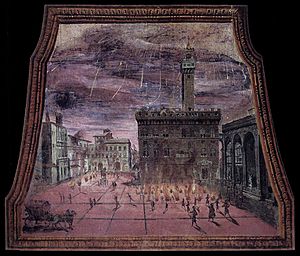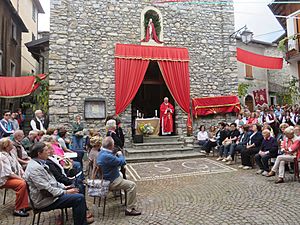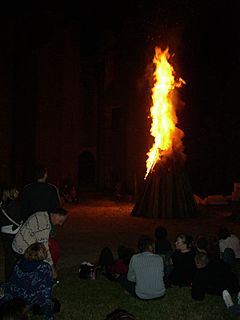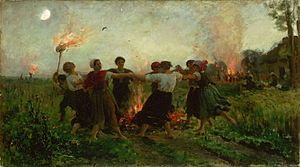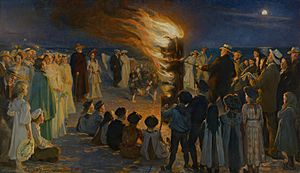Saint John's Eve facts for kids
Quick facts for kids St. John's EveEve of the Feast of Saint John the Baptist |
|
|---|---|
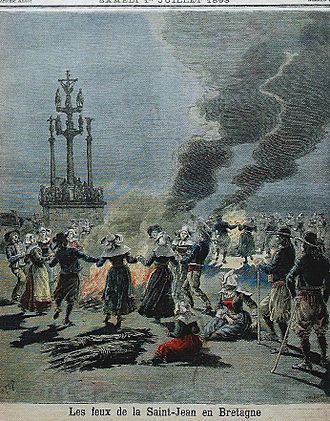
Saint John's Fire with festivities in front of a Christian calvary shrine in Brittany, 1893
|
|
| Official name | Saint John's Eve |
| Also called | Eve of the Feast of Saint John the Baptist |
| Observed by | Roman Catholic Church Lutheran Churches Anglican Communion |
| Type | Christian, Cultural |
| Significance | The eve of Saint John's Day, which celebrates the Nativity of Saint John the Baptist |
| Celebrations | Fireworks, Saint John's bonfires, visiting streams and rivers, watching theatrical dramas related to the life of Saint John the Baptist, and family gatherings |
| Observances | Church services, processions, collecting special plants (e.g. Saint John's wort) and having them blessed by a priest/minister |
| Ends | 24 June |
| Date | 23 June |
| Next time | 23 June 2026 |
| Frequency | Annual |
| Related to | Nativity of Saint John the Baptist |
Saint John's Eve is a special night of celebration. It starts at sunset on June 23rd. This evening is the night before the Feast Day of Saint John the Baptist.
The Christian Bible says that John was born six months before Jesus. Because of this, the feast day for John the Baptist is on June 24th. This is exactly six months before Christmas, which is on December 25th. This feast day is one of the few saint days that celebrates a birth, not a death.
Saint John's Day happens very close to the June solstice. This is the longest day of the year in the Northern Hemisphere, also called Midsummer. The Christian holiday is set for June 24th. But in most places, the parties and fun happen the night before, on Saint John's Eve. People celebrate this holiday in many countries around the world.
Contents
History of Saint John's Eve
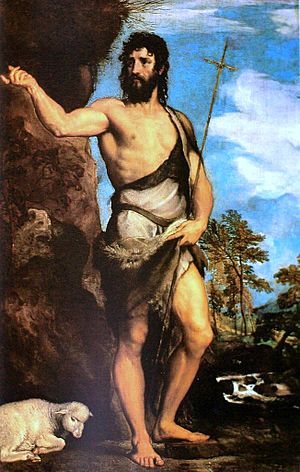
The feast day of Saint John the Baptist was started by the Christian Church in the 4th century A.D. This was to honor the birth of Saint John the Baptist. The Christian Bible says he was born six months before Jesus. Since Western Christian Churches celebrate Jesus' birth on December 25th (Christmas), Saint John's Day was set for exactly six months earlier.
In Christian beliefs, John the Baptist was seen as someone who "prepared the way for Jesus." The Bible verse John 3:30 says, "He must increase, but I must decrease." This is shown by the sun. After the summer solstice (around June 24th), the days get shorter. After the winter solstice (around December 25th), the days get longer.
By the 6th century A.D., many churches were built to honor Saint John the Baptist. A special evening, Saint John's Eve, was added to the feast day. Christian priests would hold three church services to celebrate.
In the city of Florence during the Middle Ages, midsummer parties were a chance to act out stories from John the Baptist's life. The feast day had parades, big meals, and plays. It ended with a fireworks show that everyone in the city watched.
Lighting festive fires on Saint John's Eve was first written about in the early 12th century. This was by Jean Belethus, a religious scholar in Paris. In England, people first wrote about this custom in the 13th century. Young people would gather to sing songs and play games.
A Christian monk wrote in the 15th century about the fires:
In honor of St John, people stay awake in the evening. They make three kinds of fires: one is only bones, no wood, and is called a bonfire. Another is only wood, no bones, and is called a wakefire, because people sit and stay awake by it. The third is made of both bones and wood, and is called St John's Fire.
In the 16th century, the historian John Stow described Saint John's Day celebrations:
Wealthy people would set out tables near the bonfires. On the evening before, they had sweet bread and good drinks. On the feast day, they had plenty of food and drinks. They would invite their neighbors and travelers to sit and be happy with them. They praised God for his gifts. These fires were called bonfires because they brought good friendship among neighbors. People who had argued before would become friends again. The fires were also thought to clean the air. On the evening of St John the Baptist's Day, every door was decorated with green birch, long fennel, St John's Wort, and white lilies. They also had glass lamps with oil burning all night. Some hung iron branches with hundreds of lamps lit at once, which looked beautiful.
These fires, often called Saint John's Fires, were lit to honor St. John. They were also believed to help keep away bad luck or scary things. Saint John's Day was also a popular day for infant baptisms. In the 19th century, people would act out baptisms. In Sweden, young people visited holy springs. This was a reminder of how John the Baptist baptized Jesus in the River Jordan.
Also, in the past, people carried lit torches on Midsummer-eve. This was a symbol of St. John the Baptist, who was called "a burning and shining light." On Saint John's Eve, goatsbeard and masterwort plants were made into a cross. Then they were taken to a local church to be blessed by a Christian priest.
Today, common Saint John's Eve and Saint John's Day traditions include parades, church services, bonfires, fireworks, and big meals.
Symbolic Elements of the Celebration
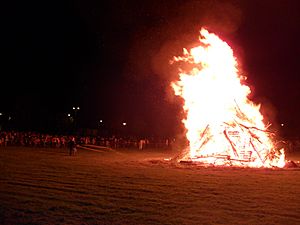
Fire and Bonfires
Fire is the most common symbol for Saint John's Eve. In many countries, people light bonfires on the evening of June 23rd. Sometimes, people even jump over the flames!
- In Croatia, the holiday is called Ivanje. It is celebrated on June 23rd, mostly in the countryside. People build bonfires (Ivanjski krijesovi) by lakes, rivers, or on beaches. Young people jump over the flames as a tradition.
- In Denmark, families and friends often have dinner together. If the weather is nice, they go to a bonfire. A bonfire with a witch doll on top is lit around 10 pm. Before the fire, someone often gives a speech. People used to believe that Saint John's Eve had special powers and that bad forces were active. They thought witches flew on broomsticks to a mountain called the Brocken. To keep bad forces away, bonfires were lit on high ground. Putting a witch doll (made of old clothes and hay) on the bonfire became common in the 20th century.
- In parts of Ireland, especially the north-west, Bonfire Night is on St. John's Eve. Bonfires are lit on hilltops. Many towns have "Midsummer Carnivals" around this time, with fairs, concerts, and fireworks. In County Cork and County Louth, this night is called bonfire night. It is one of the busiest nights for fire services.
Medicinal Plants
Traditionally, women gather different plants on St. John's Eve. These plants vary by area. They often include fennel, rue, rosemary, lemon verbena, mallows, foxgloves, and elder flowers. On the Feast of St. John, people gather the plant "St. John's Wort". Since the Middle Ages, this herb has been hung over doors, windows, and religious pictures. This was believed to keep away bad luck. It is also used as medicine. In some places, these plants are put in water and left outside overnight. The next morning, people wash their faces with this "flower water." Goatsbeard and masterwort are made into a cross. Then they are taken to a local church to be blessed by a Christian priest.
Yarrow has been used for a long time to heal wounds. Its oil helps with swelling. Yarrow was also used to protect against bad things. It was traditionally burned on the eve of St John's Day.
Bracken (Pteris aquilina) is sometimes called "brake" or "female fern." People used to believe that if you gathered its tiny spores on St. John's Eve, at the exact moment the saint was born, you would become invisible.
In Denmark, the celebration is called sankthans or sankthansaften ("St. John's Eve"). It was the day when wise people would gather special herbs. They would use these herbs for the rest of the year to help people who were sick.
In Galicia, these herbs are called herbas de San Xoán. Usually, seven types of herbs are left in a tub of water all night to collect dew.
Music Inspired by Saint John's Eve
Modest Mussorgsky's music piece Night on Bald Mountain was first called St. John’s Night on the Bare Mountain. The first version came out in 1867. He changed it in 1872 and again in 1880. In the last version, he added a beautiful quiet ending. A church bell rings, announcing the morning, and daylight chases away the bad spirits. Night on Bald Mountain has been a favorite since it appeared in Walt Disney’s movie, Fantasia.
Traditional Foods
In Connacht, Ireland, a special dish called "Goody" was made. This was white bread soaked in hot milk and flavored with sugar and spices. It was usually made in a large pot on the community bonfire or a smaller fire nearby. People brought their own spoons and bowls to share the "Goody."
Celebrations Around the World
Brazil
Canada
In Quebec, Canada, French settlers brought the celebration of St John's Day. Big fires were lit at night. The first celebrations in New France happened around 1638. They took place on the banks of the Saint Lawrence River on the evening of June 23rd, 1636, with a bonfire and cannon shots. In 1908, Pope Pius X named John the Baptist the patron saint of French-Canadians.
Croatia
Croats celebrate "Ivanjske krijesove" on the evening of June 23rd with bonfires. This honors St. John the Baptist. People gather branches and set them on fire. Children and young people jump over the flames. The celebration is also about water, good harvests, and cleaning rituals. In older times, girls would throw flower wreaths into the water. How they floated would tell them about the future.
Denmark
Saint John's Eve (Sankthansaften) is celebrated in Denmark much like Walpurgis Night in Sweden. At dusk, large bonfires are lit all over the country. People often sing Midsommervisen together. On top of each bonfire, there is often a doll of a witch. This goes back to times when people believed in witches. People believed that witches flew to a mountain called the Brocken. The bonfires were lit to scare witches away. Today, when the witch doll catches fire, people say she is "flying away to Brocken." On Saint John's Eve and Saint John's Day, churches hold services. Families also get together to eat and drink.
England
The feast of St. John the Baptist is one of the "quarter days" in England. The town of Midsomer Norton is sometimes said to be named after this feast day. Wynkyn de Worde (died 1534) from old England cooked a special soup for the day, following his ancestors' traditions.
In Yorkshire, it was a custom for new families in a parish to put a table outside their house on St. John's Eve. They would offer bread, cheese, and beer to anyone passing by. Anyone from the parish could help themselves. If the family could afford it, they would invite people inside for more supper and a fun evening. This helped new people meet others and feel like they belonged in the community.
The Golowan festival in Penzance, Cornwall, was started in 1991 to bring back the celebration of St John's Feast. Today, it has a torchlit parade. In the 19th century, the town had bonfires, burning tar barrels, and homemade fireworks in the streets.
Estonia
Estonians celebrate "Jaaniõhtu" on the evening of June 23rd with bonfires. On the islands of Saaremaa and Hiiumaa, old fishing boats might be burned in the large fires. On Jaaniõhtu, Estonians gather with their families or at bigger events. They celebrate with singing and dancing, as they have for centuries. These celebrations usually last all night. They are the biggest and most important of the year. The traditions are very similar to those in Finland, Latvia, and Sweden.
Finland
France
In France, the "Fête de la Saint-Jean" (feast of St John) is a Catholic holiday. It is traditionally celebrated with bonfires (le feu de la Saint-Jean). These fires are like older Midsummer traditions. It takes place on June 24th, which is Midsummer day. Today, it is not celebrated as much. In some French towns, people build a tall bonfire to be lit on St John's Day. In the Vosges region, this huge bonfire is called "chavande."
Germany
Besides many Midsummernight festivals, the Mainzer Johannisnacht in Mainz celebrates Johannes Gutenberg, who was born there. This festival has been held since 1968.
Greece
The evening of St John's feast is linked to jumping over bonfires. It's also connected to a love and marriage fortune-telling game called Klidonas. People also pick wild oregano before sunrise. St John is sometimes called Riganas (the oregano bearer) and Lampadiaris (the bonfire bearer). Bonfire jumping was common until the 1970s. Now, it is mostly done as a revived folk performance.
Hungary
On June 21st, Hungarians celebrate "Saint Ivan's Night" (Szentiván-éj). The whole month of June was once called the Month of St. Ivan. Lighting fires is a folk tradition on this night. Girls jumped over the fires while boys watched. The most important custom of the summer is lighting the Midsummer Night fire (szentiváni tűzgyújtás) on St. John's Day (June 24th). This is when the sun is highest, and the nights are shortest. In the Middle Ages, it was mainly a church holiday. But from the 16th century, it became a folk custom. The main part of the custom is lighting the fire.
Ireland
The celebration is also called a "Tine Cnámh," which means "Bone Fire." Often, the oldest person present would light the fire. The youngest person would throw a bone into the fire as part of the fun. After the dancing and celebrations, people would take home a burnt ember from the fire. This was thrown into a field to bring good luck for the next year.
The poet Aubrey Thomas de Vere described "Bonfire Night" in his 1861 poem "The Sisters." He wrote about how the Irish people still celebrated, even after hard times.
Irish St. John's Day Eve traditions included: A few days before, children and young people would ask for donations for the bonfires. It was considered bad luck to say no. The bonfires were meant to bring God's blessings on the summer crops. People would jump over the bonfires. Bonfire ashes would be spread on the crops for good luck. Most annoying local weeds would be burned in the bonfire to help keep them away. Men would walk through their fields with lit torches. Then they would throw the torches onto the bonfire to bless the crops.
People at the bonfires would bring food and drinks. Potatoes were often roasted around the fire. Cattle would be led through the ashes of the bonfires. Around this time of year, St John's Wort and foxgloves were gathered. The wort was believed to protect against bad luck, and both were used as medicine.
In coastal areas of Ireland, priests would bless fishermen's boats and nets on St John's Eve. A community salmon dinner was traditionally served on this day in Portballintrae, County Antrim. The sweet milky dish goody was also served. Sometimes, it was made at the bonfire in a large pot for younger people.
Italy
The feast of Saint John the Baptist has been celebrated in Florence since medieval times. In the Renaissance, festivals sometimes lasted three days, from June 21st to 24th. Similar celebrations happen today in Cesena from June 21st to 24th, with a special street market. Saint John the Baptist is the patron saint of Genoa, Florence, and Turin. In Turin, a fireworks display takes place during the celebration on the river. In Turin, Saint John's celebration has been strong since the Middle Ages. The city would stop work for two days. People from nearby areas would gather to dance around the bonfire in the main square. In Genoa and coastal Liguria, it is traditional to light bonfires on the beaches on Saint John's Eve. This remembers the fires lit when Saint John's relics arrived in Genoa in 1098. Since 1391, on June 24th, a big parade in Genoa carries the relics to the harbor. There, the Archbishop blesses the city, the sea, and those who work on it.
Jersey
In Jersey, most of the old midsummer customs are not followed much anymore. The custom called Les cônes d'la Saint Jean was still done in the 1970s. People would blow horns or conch shells. Ringing the bachîn (a large brass pot) at midsummer to scare away bad spirits was a custom on some farms until the 1940s. It has been brought back as a folk performance in the 21st century.
Latvia
Lithuania
Norway
In Norway, like other Scandinavian countries, this event is celebrated with a community bonfire. The event is also called Jonsok, which means "wake of Saint John."
Philippines
In the Philippines, the festival is a celebration of thanks. People do a traditional "basaan," which means dousing each other with water in the streets. This is a way of sharing good blessings. Parades, street dance competitions, and other activities make the annual celebration lively.
Poland

In Poland, the festival is known as 'noc świętojańska' (Christian) or 'Noc Kupały' (Kupala Night) and 'sobótka' (older traditions). Traditional folk rituals include groups of young men and women singing songs to each other. Young women might wear crowns made from wild flowers. These are later thrown into a nearby pond or lake. The boys or young men might then swim out to get one of the crowns. Bonfires and jumping over bonfires are also part of the celebrations.
Portugal
There are St John's street parties in many cities, towns, and villages. They happen mainly between the evening of June 23rd and St. John's Day on June 24th. St John's night in Porto (Festa de São João do Porto) has been called "one of Europe's liveliest street festivals." It is not very well known outside Portugal. The actual Midsummer, St John's day, is celebrated more in Porto and Braga.
Puerto Rico
On the island of Puerto Rico, which was named San Juan Bautista (Saint John the Baptist) by Christopher Columbus, a night-long celebration called "La Noche de San Juan" is held. After sunset, people go to a beach or any water (like a river, lake, or even a bathtub). At midnight, they fall backward into the water three, seven, or twelve times. This is done to wash away bad luck and bring good luck for the next year.
Shetland Isles
The Johnsmas Foy festivities in the Shetland Isles also happen in the week leading up to June 23rd/24th. The people there are proud of their Nordic roots. These celebrations might also come from the Scandinavian St John's Eve parties.
Spain
The traditional midsummer party in Spain is the celebration for Saint John (Spanish: San Juan, Catalan: Sant Joan, Galician: San Xoán). It takes place on the evening of June 23rd. This midsummer tradition is very strong in coastal areas of Spain, like in Galicia. There, San Xoán festivals happen all over the region. Bonfires are lit, and there are usually fireworks. On the Mediterranean coast, especially in Catalonia and Valencia, bonfires are also traditional. Special foods, like Coca de Sant Joan, are served. There is also a big festival in Ciutadella, Menorca. Many other cities and towns across Spain have their own unique traditions for the festival.
In Alicante, the Bonfires of Saint John are the most important festival. They take place from June 20th to 24th.
Bonfires are also used in the Basque Country to celebrate San Juan Eguna (the feast of St. John the Baptist). This marks the Basque Summer Solstice. In some towns, the celebration includes more parties and dances.
In Castile and León, there is the Firewalking Festival of San Pedro Manrique (Soria). Here, men walk barefoot across the hot coals of a prepared bonfire.
Sweden
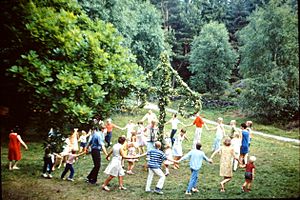
This holiday is usually called 'midsummers eve' or Midsommar in Sweden. It was originally a tradition from before Christianity. Over time, Christian traditions and the celebration of Saint John have influenced it. But it has not changed its name, unlike in Norway and Denmark. A main symbol today is the 'midsummer pole.' This is a maypole that is put up on Midsummer's Eve. The pole is a tall wooden pole covered in leaves and flowers. People dance around the pole and sing songs. Other traditions include eating pickled herring with fresh potatoes, often the first from the season's harvest. This is served with sour cream and chives. It is the biggest holiday of the year in Sweden, besides Christmas.
One Swedish midsummer tradition is that girls should pick seven different flowers from seven different fields. The flowers should then be placed under their pillow on Midsummer's Eve night. This night is thought to be magic. The girl is then supposed to dream of her future husband while sleeping.
Another common tradition in Sweden is to make midsummer wreaths from flowers.
United States
Historically, this date has been important in Louisiana Voodoo. The famous Voodoo priestess Marie Laveau was said to have held ceremonies on the Bayou St. John, in New Orleans. These ceremonies honored St John's Eve. Many New Orleans residents still keep this tradition alive.
See also
 In Spanish: Fiesta de San Juan para niños
In Spanish: Fiesta de San Juan para niños


